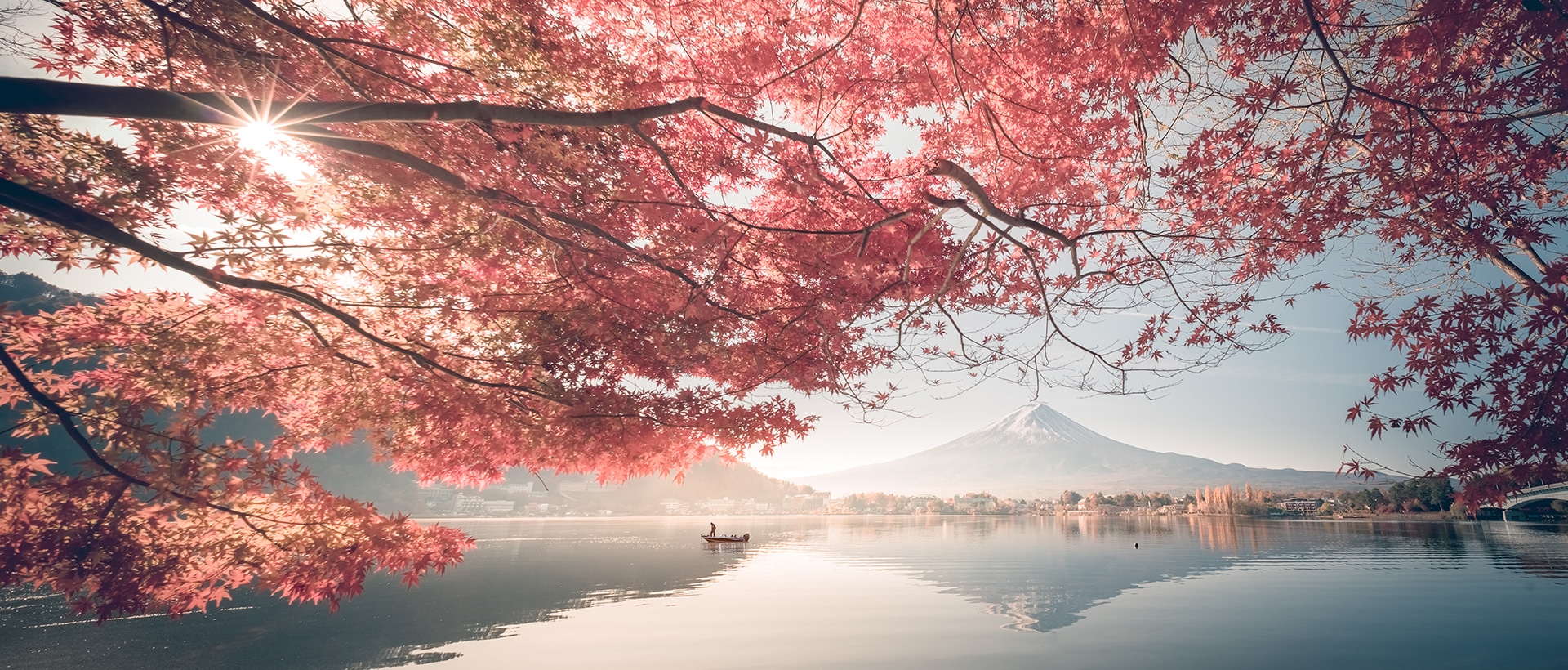When is the Best Time to Visit Japan?
The best time to visit Japan, season by season.
- Tailormade itineraries planned around your travel dates
- On-the-ground knowledge about the weather from local experts
- One-of-a-kind experiences for every season
- 24/7 support from our team members

In a country as wonderfully diverse as Japan, it doesn’t matter what time of year you choose to travel, there will always be plenty of fantastic activities and experiences to be enjoyed. At Scott Dunn, our travel experts know the best times to travel to Japan and can help you plan the perfect trip based on what you want to see and do.
Typically, spring (March to May) and autumn (September to November) are the best times to go to Japan, since this is when the country’s naturally breathtaking scenery comes alive. Spring marks the anticipated cherry blossom season in Japan, with beautiful pink and red blooms making for a wonderful backdrop everywhere you go. If you’re hoping to see the blossoms, it’s worth noting that spring is the busiest time of year to visit, with tourists flocking to destinations across the country to see it but we can give tips on how to get off-the-beaten-track and avoid the crowds. Read on for more insider knowledge on when to travel to Japan.
Monthly Climate Guide for Japan
, Japan
Average temperatures (Celsius) and rainfall (mm)
Our Experts Say...
"The best times to visit Japan are from early-March to late May and from early October to early December. The Cherry Blossom season typically falls between the last week of March and the first week of April. The autumn leaves typically come into full colour towards the end of October and last through to the end of November. Cherry Blossom and autumn can both be very busy and particularly expensive times to travel. To avoid the crowds, consider travelling in early March or between mid-April and late May. Early December is also a great time to travel. Summer can be very hot and humid in Japan, especially in August and September when there's a greater risk of typhoons. If you have to travel during the summer months, Japan is very equipped for extreme weather and most trips go without a hitch! Christmas and New Year as well as Golden Week in mid-May and Obon in mid-August are the only periods to really avoid a Japan trip due to bigger crowds and some facilities closing for the holidays."
Rikki Poynton, Asia Specialist
Best Time to Visit Japan FAQs
-
You should book at least a year in advance to ensure we can get you the best hotels, experiences, and flight options for you, especially if you want to see cherry blossom.
-
Yes, two weeks in Japan will allow you enough time to travel around and see quite a bit of the country. It’s the same size as Germany and has excellent transport links, including the bullet train, which will take you from north to south at 200 miles per hour. Our suggested tours to Japan are between 7 and 12 nights.
-
The best time to visit Japan for the autumn colours, also known as koyo, is from late September to November. The red, orange, and yellow landscape begins in northern Japan, followed by Tokyo and Kyoto in November before decorating Kyushu and Shikoku later in November.
-
The best time to visit Japan and China is during spring, from March to May – before it gets too hot and humid in the summer in both countries – and autumn when the summer heat and risk of typhoons have lifted.
-
The best time to visit Japan and South Korea is generally during the spring months of April and May when both countries experience pleasant weather, cherry blossoms in full bloom, and lots of cultural festivals to enjoy.
Call us on 020 8682 5060 to start planning
Japan is made up of four main islands and more than 3,000 smaller islands, with the Pacific Ocean on its east coast and the Sea of Japan on its west coast, both of which influence its climate. As a result, the north of the country has cold winters and warm summers, while the south has more of a tropical climate, with warm weather most of the year, including hot, humid summers. That said, across the country, Japan has four distinctive seasons, marked by an obvious change in the landscape and weather patterns.
Spring, the best time to visit Japan for cherry blossoms, runs from March to May and brings with it average temperatures between about 19°C and 28°C depending on where you are in the country. The mountainous areas of Northern Honshu are the coldest, but also driest. You might see a bit of rainfall, particularly in April around Hakone and Mount Fuji but mostly it will be crisp blue skies.
Summers, from June to August, in Japan are hot and humid. You’ll have average temperatures that range from 30°C to 37°C. This is also the rainy season for Japan, although it varies across the country. The general rule of thumb is the further west you go the more rain there is. The wettest regions are Hakone and Mount Fuji, Kyoto, Kyushu and Tokyo in July.
Along with spring, autumn is the best time to visit Japan. The weather stays in the 30s and high 20s throughout September and October, some parts see a little bit of rain but it’s mostly sunshine. Temperatures drop gradually as winter arrives in December, with most of Japan being around 15°C at the coldest time of year in January and February. Again, the Honshu Mountains see the coolest days, which can be between 8°C and 11°C depending on altitude.
The Best Time to Go to Japan by Season
The best time of year to go to Japan depends on the kinds of experiences you’re looking for.
During the summer months, Japan’s northern national parks and mountainous regions are ideal for hiking, biking and exploring, while the south becomes hot and humid. If you’d like to visit Japan’s largest cities, Tokyo and Osaka, spring or autumn are the best times to visit, as the weather stays comfortable and the country showcases its stunning colours.
No matter when you’d like to travel, our experts will gladly plan a tailor-made itinerary that combines the best experiences for each of Japan’s seasons, so you can just sit back, relax, and focus on making the most of your luxury Japan holiday.
A Seasonal Guide to Japan
-

March, April, May
With warm temperatures across the country, spring is one of the best times of year to visit Japan. Wander through the streets of Tokyo before the summer heat sets in or take a trip to lesser-known locations like Kumano Kodo and Miyajima to see some of Japan’s most beautiful shrines and cultural sites.
If you’re looking for the best time to visit Japan for cherry blossoms, spring is your season. Magical blossoms will appear across the northern parts of the country from March to May and are an unforgettable sight. However, you should be aware that this is a popular time to travel so attractions will be busy and hotels may be more expensive than at other times of the year and you need to book more than a year in advance.
-

June, July, August
Summer in Japan is hot and humid, with heavy rainfall across most of the country. This means that Japan’s gardens and forests are at their most vibrant, making this a great time to visit destinations across Northern Honshu and take in the beautiful natural scenery, clear lakes and impressive mountains.
Destinations outside of the cities can be slightly cooler during the summer months and are a popular option for most travellers. An hour from Tokyo, the mountain resort of Karuizawa provides cool air and a range of outdoor activitiesuch as hiking, visiting temples, and picking its famous blueberries, making it an ideal summer destination.
-

Autumn in Japan
Autumn is one of the best times of year to visit Japan to enjoy both its bustling cities and breathtaking natural landscapes. As temperatures and crowds begin to die down, travel to Japan in September or October to cities like Kyoto, a fascinating place full of history. Take in the UNESCO-listed Nijo Castle Garden or learn about geisha life and attend a traditional tea ceremony to immerse yourself in Japan’s rich culture. For those looking to hike Mount Fuji without the summer crowds and high temperatures, autumn is also the time to do so, with the climbing season coming to a close at the end of September.
Alternatively, to make the most of the beautiful red and gold hues that sweep across Japan during this time, we recommend a trip to Shikoku Island. A relatively undiscovered gem, Shikoku is perfect for observing the breathtaking seasonal colours that paint Japan’s forests and mountains during the autumn months.
-

Winter in Japan
If you’d like to avoid the tourists, a winter is a good time to visit Japan - as long as you don’t mind the cold! With temperatures in the mid-teens and dry weather, winter is when to visit popular sites and attractions without worrying about long queues or large crowds.
For a magical, snowy experience and a taste of Japanese culture include Aomori on your winter itinerary. Stay at a ryokan hotel, such as Kai Tsugaru which is known for its onsen. This traditional outdoor hot spring is a must-visit attraction and a great way to warm up in the cold weather.
If you’re travelling with little ones, we also recommend visiting Yudanaka to see the famous snow monkeys.
- March, April, May
- June, July, August
- Autumn in Japan
- Winter in Japan
Best time to visit Japan for…
Cherry Blossoms
Heralding the start of spring, Japan’s cherry blossoms (known as sakura) are of huge cultural significance. Symbolising the transient nature of life and the beauty that can be found in it, this treasured flower is also a reminder of Japan’s changing seasons. Cherry blossom season in Japan doesn’t last long; it’s only a couple of weeks from when they’re in full bloom to when they drop to the floor. However, not everywhere flowers at once, the phenomenon sweeps from south to north, meaning you can see the pink beauties in different parts of the country for a few months.
The best time to visit Japan for cherry blossoms is March and April. The first sighting usually takes place in January or February in the southernmost prefecture of Okinawa, and from here the blooms gradually move north, arriving around Tokyo and Kyoto between late March and early April.
People take picnics, drink sake, and celebrate the blossoms with friends and family, so parks and gardens can become very busy. You will need to book flights and accommodation at least a year in advance too if you’d like to visit Japan in spring.
Some of the best places to see cherry blossoms in Japan include:
- Osaka Castle, Osaka
- Philosopher’s Path, Kyoto
- Maruyama-koen Park, Kyoto
- Imperial Palace Park, Kyoto
- Kamo-gawa River, Kyoto
- Hakone National Park, Hakone
- Shinjuku Gyoen National Garden, Tokyo
- Chidorigafuchi Moat of the Imperial Palace, Tokyo
- Yoyogi Park and Rikugien Garden, Tokyo
- Kenrokuen Garden, Kanazawa
Foodie Experiences
Japan’s food is one of the top reasons to travel to the country. From hidden, Michelin-star restaurants to vibrant street food scenes, you need to go hungry. There is no one best time to travel to Japan for its food experiences. Throughout the year, there are celebrations either to honour a particular food, such as the oyster festival in Miyajima during the first weekend of February, or dishes are used to mark an occasion. In the autumn, traditional dumplings, known as tsukimi dango, are eaten to celebrate the moon-viewing festival of Tsukimi. And, to celebrate Lunar New Year, people eat the sweet dessert mochi to hope for good luck in the year ahead.
At home and in restaurants, Japanese people eat very seasonally, for example, in spring, the famous cherry blossoms are used as ingredients and admired for their beauty. In the summer, look out for omen, thin wheat noodles served chilled with dipping sauce, or cool off with kakigori, a fluffy, shaved ice dessert flavoured with syrup, often topped with sweetened condensed milk or fruit. In autumn, mushrooms are the focus of many menus, while, if you visit Japan in the winter, it’s all about steaming bowls of ramen or the multi-coursed kaiseki meals, which are made up of seasonal ingredients, served when staying at ryokans and a major highlight of a holiday in Japan for foodies.
Throughout the year, there are many food festivals and events in Japan. Here are some to look out for:
- Gourmet & Food Festival, Osaka, October
- Fukuoka Hakata Dontaku Port Festival, Kyushu, May
- Nishiki Market Ameichi, Kyoto, January
- Nada no Kenka Matsuri (Nada Fighting Festival), Himeji, October
- Kyoto Ramen Koji Festival, Kyoto, October/November
- Takayama Spring Festival, Takayama, April
For smaller crowds
For those of you who don’t want to travel with the masses and avoid the crowds or queues, the best time to go to Japan is between February and March, after the New Year rush and before the cherry blossom season begins; late spring (May), after the cherry blossom season, but before the start of the Golden Week holidays, which is from the end of April to early May; June, before the rain sets in and in September/October.
There are some parts of Japan, which are off-the-beaten-track and attract fewer crowds, such as Aomori in Northern Honshu, which is full of stunning landscapes and cultural experiences with fewer tourists compared to popular destinations like Tokyo or Kyoto. Shikoku Island, which is known for its pilgrimage trails, scenic coastline, and tranquil atmosphere, is quieter than the likes of the other major islands of Honshu and Kyushu. Places like Kumamoto, Kagoshima, and Miyazaki within Kyushu allow you to experience rich history, hot springs, and delicious cuisine in relative peace compared to the more popular Fukuoka and Nagasaki.
There is, of course, a reason that the popular sites are popular and if you don’t want to miss out on seeing key attractions but still want to travel at the best time to see Japan, you can visit them very early in the morning or late at night. Mid-week will be quieter than weekends and public holidays, and for the best restaurants, consider eating later or earlier than the usual rush. Our travel experts will plan your itinerary to best suit your taste, so if you’d like to avoid the crowds, they’ll help you do exactly that.

Our team of travel specialists are waiting to help you book your next adventure.










